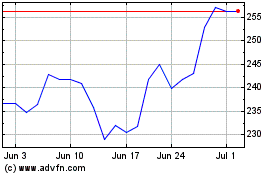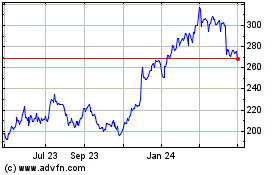A D&I officer at the top can make all the difference
By Dieter Holger
This article is being republished as part of our daily
reproduction of WSJ.com articles that also appeared in the U.S.
print edition of The Wall Street Journal (October 28, 2019).
When Dow Inc. named Karen S. Carter as chief inclusion officer
in 2017, the chemical company became only the fifth member of the
S&P 500 to elevate such a role to the C-suite. That group
hasn't grown since.
Ms. Carter, who has held various leadership roles at Dow for
more than two decades, took the job knowing that the company and
its 37,000 workers still had a long way to go. In its first
inclusion report, published last year, Dow said that about 81% of
its U.S. employees are white and 72% of its global workers are
men.
The decision to place a diversity and inclusion officer in the
C-suite is a "game-changer," Ms. Carter says, because support from
the top is essential to making meaningful changes.
"We knew we needed not only to make short-term progress, but to
embed it into the way we do business as a company," she says. "It's
critical to have that voice, that perspective in the room."
Other companies that have added so-called D&I officers to
the C-suite are Brown-Forman Corp., Interpublic Group of Cos.,
Comcast Corp. and Salesforce.com Inc. For the rest of the S&P
500, 43% have D&I managers who typically work under the
umbrella of human resources, while the majority don't have a
dedicated management position, according to a study of the
blue-chip index by The Wall Street Journal's environment, social
and governance research analysts.
Among the 10 categories on which the study scored the S&P
500 members, companies received top marks if they had an executive
director in the C-suite in charge of diversity and inclusion and
partial credit if they had a manager in charge of D&I. It was
one of the worst-performing areas, right above gender diversity in
the board, senior management and the overall workforce, weighing
down the scores of the vast majority of S&P 500 companies. (See
the full methodology.)
"It is surprising that given the known benefits associated with
workforce diversity that more CEOs are not looking to integrate
these considerations at the board level," says Martin Buttle, head
of good work at ShareAction, a U.K.-based advocacy group that
mobilizes investors on social issues.
The creation of these roles is supported by a growing body of
evidence showing that diversity is good for business. This year,
85% of CEOs globally said they saw enhanced performance after
investing in D&I programs, according to a survey of 1,378 CEOs
by PricewaterhouseCoopers.
At Dow, Ms. Carter has worked with its business leaders to add
diversity and inclusion to their strategy, ensuring they understand
it is tied to financial success. Each division of the company has
targets and programs, she says.
"There are so many inclusion efforts going on at the company, I
probably can't put my arms around them," she says. "And I'm
comfortable with that."
Diversity and inclusion executives often have a broad mandate --
from hiring and communications to even how goods and services are
created and sold. The duties of these executives vary from company
to company, but those elevated to the C-suite tend to look beyond
the workforce into government relations and marketing.
Even though the job is still nascent and evolving, these
officers have an important role to play if companies want to
promote equality, says Charlotte Laurent-Ottomane, executive
director of the Thirty Percent Coalition, a nonprofit working to
increase gender diversity in senior management. The organization is
working with corporations on what the purpose of the chief
diversity officer should be.
At tech companies like Salesforce -- the second-most-recent
company to add a C-suite diversity officer -- data can occupy a
large amount of that executive's focus. Salesforce, which makes
business software, appointed Tony Prophet in late 2016 as its first
chief equality officer, reporting to Chairman and co-Chief
Executive Marc Benioff.
Mr. Prophet, who previously held executive roles at Microsoft
Corp., oversees Salesforce's new office of equality, which has a
staff of 13 working on D&I efforts across the company,
including 12 employee groups and monthly data updates to business
leaders. Leaders receive reports on how many women or members of
underrepresented groups have been hired or promoted in the U.S., or
have left divisions in the organization, Mr. Prophet says.
"We have found that this helps our leadership keep equality top
of mind, " he says.
Nearly a decade before Salesforce, advertising company
Interpublic and spirits-and-wine maker Brown-Forman were the first
movers in the S&P 500 when they appointed C-suite-level D&I
officers in 2007.
"Whether or not companies make the move is dependent upon the
mental models of the CEOs, the board and other C-suite members,"
says Ralph de Chabert, chief diversity inclusion and global
community relations officer at Brown-Forman.
Mr. de Chabert, who was briefly chief diversity officer at
grocer Safeway Inc. and spent seven years at health-care provider
McKesson Corp., has overseen the creation of nine employee groups
and 15 diversity councils at Brown-Forman. He also works on
marketing the company's alcohol to diverse consumers.
Some executives say having a diversity executive in the top
ranks is crucial to distinguish the role from HR. Comcast, for one,
has kept its diversity efforts at the C-suite level and focused on
issues outside of HR for well over a decade. In an interview, David
Cohen, senior executive vice president and chief diversity officer
at Comcast, says HR isn't able to incorporate diversity across an
entire business.
"What does an HR person have to do with supplier diversity? What
does an HR person have to do with governance?" he says. "A chief
diversity officer in the HR space is effectively a chief diversity
officer for the workforce."
Mr. Cohen was named Comcast's first diversity officer during
talks to acquire NBCUniversal in late 2010. The company's plans to
improve diversity came under scrutiny from Congress and nonprofits
ahead of the acquisition, Mr. Cohen says, and members of Congress
wanted to know how the company would improve its diversity profile,
especially its programming.
"It was more a matter of formalizing what I was already doing
with the title," he says. "It's not like my job changed."
Mr. Cohen says Comcast applies diversity standards to its
governance, workforce, suppliers, charitable work and, importantly,
its programming, both at Comcast cable and NBC. He pointed to the
hiring of Lester Holt in 2015 as the first permanent
African-American anchor of "NBC Nightly News."
"We are presenting pictures and stories of America," Mr. Cohen
says.
Mr. Holger is a Wall Street Journal reporter in Spain. Email
dieter.holger@wsj.com.
(END) Dow Jones Newswires
October 28, 2019 02:47 ET (06:47 GMT)
Copyright (c) 2019 Dow Jones & Company, Inc.
Salesforce (NYSE:CRM)
Historical Stock Chart
From Mar 2024 to Apr 2024

Salesforce (NYSE:CRM)
Historical Stock Chart
From Apr 2023 to Apr 2024
